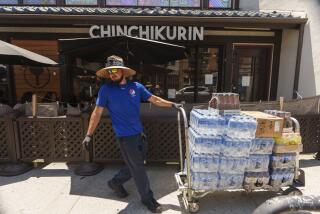Calif. Jobless Rate Eases to 6.4% in April
California’s job machine continued to sputter in April as employers skeptical about the strength of the economic recovery reduced their payrolls by 5,300 jobs, while the unemployment rate remained essentially flat.
Figures from the California Employment Development Department showed the state’s unemployment rate eased last month to 6.4% from a revised 6.5% in March. The numbers were welcome news to some economists, who had been expecting the state’s unemployment rate to rise.
Last week, government statistics showed the nation’s jobless rate spiked to a nearly eight-year high of 6% in April. A year ago, the U.S. unemployment rate was 4.5%, while California’s stood at 5%--a gap that California has since narrowed.
“On the positive side, California is doing slightly better than the U.S. as a whole,” said Kei Matsuda, chief economist with Union Bank of California. “But we’re not seeing much improvement in the [payroll] numbers. We seem to be moving sideways.”
That’s because companies remain reluctant to hire many workers until the fledgling recovery gains momentum. Matsuda and others say the state’s job trend probably will be flat over the next several months. A short, shallow recession has led to an anemic recovery lacking the vigor of previous rebounds.
“We’re still waiting for liftoff,” said Ted Gibson, formerly the state’s chief economist and now a senior economic advisor with MetWest Financial, a Los Angeles-based financial services firm. The job numbers “don’t signal a surging recovery.”
Southern California continued to post some of the lowest unemployment rates in the state. Orange County’s April jobless rate slid to 3.7% from 3.8% in March, while San Diego’s showed a similar dip to 3.8% in April from 3.9% a month earlier. Unemployment in the Riverside-San Bernardino area was 5.2%, down from 5.3% in March. Ventura County posted an April jobless rate of 4.4%, down from 4.7% the previous month.
That leaves Los Angeles County as the Southland’s weakest link. Although its unemployment rate ebbed slightly to 6.8% in April from a revised 6.9% in March, the county still has nearly 71,000 fewer payroll jobs than it did a year ago. Los Angeles’ textile and aerospace manufacturers have struggled, along with its motion picture industry. In addition, a lack of open space has severely limited new housing and commercial projects--and the construction jobs that accompany such development.
Statewide, employment gains and losses were little changed over the month. Industries showing the strongest growth included wholesale and retail trade, which added 6,200 jobs, followed by 4,900 new government jobs and 900 additional positions in finance, insurance and real estate.
But those gains were more than offset by losses in manufacturing, mining, construction, services, transportation and public utilities. The long-suffering manufacturing sector once again topped the list of losers, with 6,500 job cuts in April.
Electronic equipment was one of the biggest culprits dragging down the manufacturing sector, a sign of continued weakness in the state’s critical high-tech sector.
“The technology turnaround is still a long way off,” Matsuda said. “That’s bad news for California as a whole but especially for the Bay Area.”
The unemployment figures reflect it. Santa Clara County, the epicenter of Silicon Valley, posted a jobless rate of 7.4% in April. That’s down slightly from March’s 7.6% but up sharply from the 2.7% rate posted in April 2001.
Some analysts don’t expect orders for high-tech equipment and other capital goods to improve substantially until late 2002 or even 2003. Even when orders do pick up, many companies won’t be hiring additional workers right away.
Take Prompt Machine Products Inc. for example. Slow sales at the Chatsworth-based machine shop forced owner Mark Wilkinson to cut back the hours of his 15 workers. He expects business to pick up later this year, but not the number of names on his payroll.
“My first priority will be putting everyone back on a full [40-hour] schedule,” Wilkinson said. “I won’t be hiring anyone new this year.”
Likewise, the sizzling 8.6% first-quarter U.S. productivity figure reported earlier this year may bode well for the nation’s long-term standard of living, but it won’t do much to improve the short-term employment picture.
“Employers can increase output without increasing the number of workers,” economist Matsuda said.
Still, April’s report showed some early signs of what could develop into stronger job growth for California down the road. The hard-hit temporary help sector added 3,300 jobs in April after six straight months of decline. Temps are considered a bellwether for the larger labor market since they typically are the first to be cut in a downturn and among the first to be hired back when orders start rolling in.
Darin Meadows, Los Angeles area manager for Manpower Inc., one of the nation’s largest temporary staffing companies, said first-quarter sales for his region are up about 20% compared with a dismal final quarter in 2001.
He said many companies like the flexibility of hiring temporary help, particularly at the start of a recovery, just in case business slows down again.
“No one wants to go through the hiring process only to lay someone off right away,” Meadows said.
The unemployment rate for California’s Latino workers rose to 7.5% in April from 7.3% in March. The black jobless rate likewise increased to 10.1% from 9.7% the previous month.
San Luis Obispo boasted the lowest April unemployment rate of all California counties at 2.9%. Imperial County was the highest at 16.2%.
More to Read
Inside the business of entertainment
The Wide Shot brings you news, analysis and insights on everything from streaming wars to production — and what it all means for the future.
You may occasionally receive promotional content from the Los Angeles Times.










